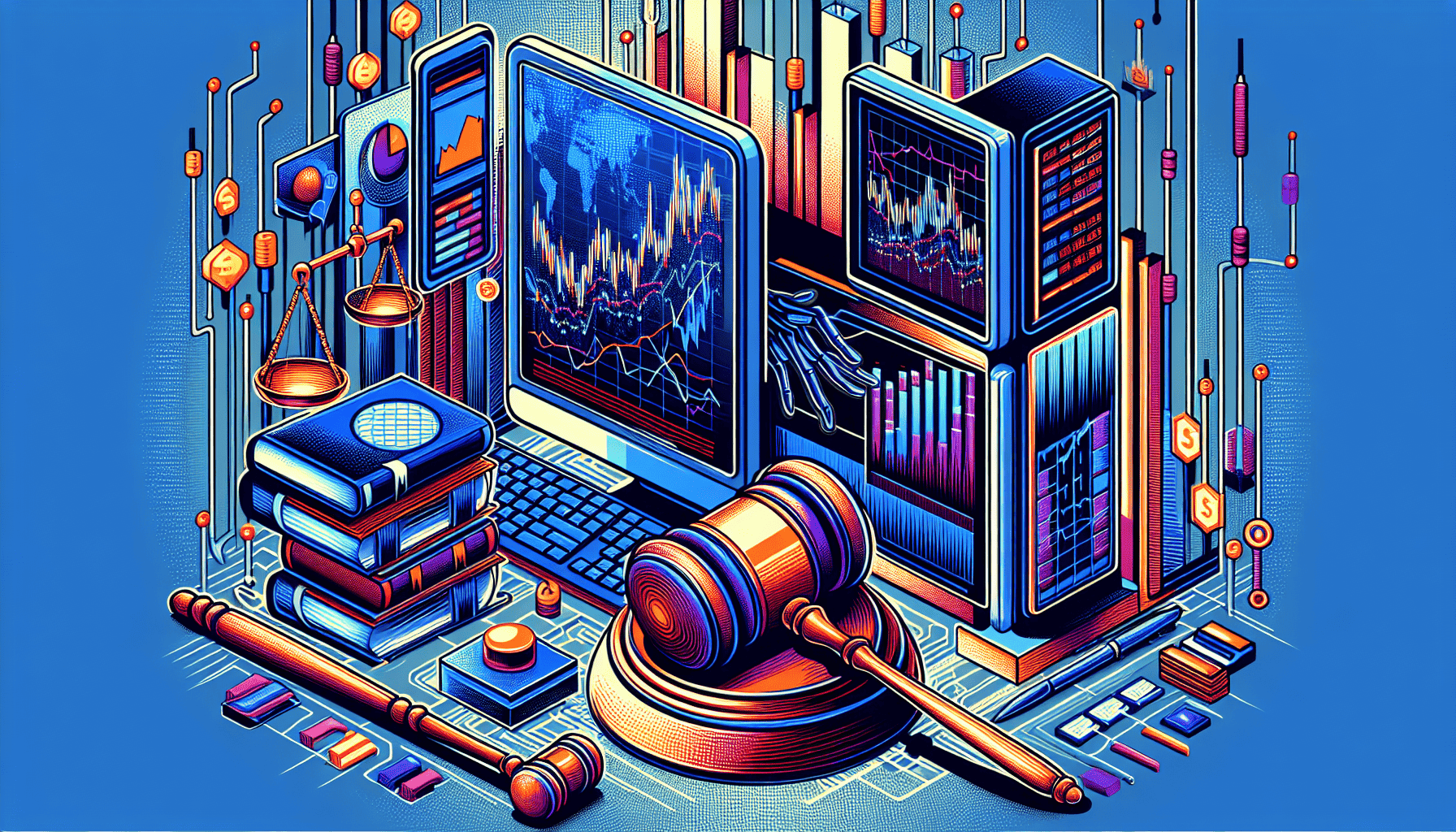Navigating the Trading Landscape: Understanding Derivatives Trading Platforms and Technology

Introduction to Derivatives Markets
The derivatives market is a complex financial landscape where a multitude of financial instruments are traded. Understanding these markets is essential for beginner investors aiming to navigate the world of finance effectively.
Defining Derivatives
Derivatives are financial instruments whose value is derived from an underlying asset or group of assets. The underlying asset can be stocks, bonds, commodities, currencies, interest rates, or market indexes. These financial contracts bind parties to buy or sell the underlying asset at a predetermined future date and price. Derivatives are primarily used for hedging risk or for speculative purposes, offering the potential for high returns but also carrying significant risks, including market, credit, liquidity, and operational risks. The advancements in derivatives trading platforms and technology have revolutionized how these instruments are traded, enhancing efficiency and functionality (Medium).
Types of Derivatives
There are several types of derivatives, each with unique characteristics and purposes:
- Forwards Contracts: Customizable agreements between two parties to buy or sell an asset at a specified price on a future date. They are traded over-the-counter (OTC) and are not standardized, offering flexibility but also higher counterparty risk.
- Futures Contracts: Standardized contracts traded on an exchange, obligating the buyer to purchase, and the seller to sell, a specific quantity of an asset at a predetermined price on a set date. They are marked to market daily, and their standardized nature facilitates liquidity and lowers credit risk. Learn more about understanding futures contracts.
- Options Contracts: Contracts that give the holder the right, but not the obligation, to buy (call options) or sell (put options) the underlying asset at a set price within a specific time frame. Options can be used for hedging or speculation and offer asymmetric payoff profiles. Explore more on exploring options trading.
- Swaps: Agreements to exchange cash flows or other financial instruments, commonly used for exchanging fixed interest rate payments for floating-rate payments between parties. Swaps can be used for hedging against or speculation on changes in market conditions. Find out more about the world of swaps: interest rate and currency.
Each derivative type can be an essential tool for investment strategies, such as hedging strategies using derivatives, and can be found on various trading platforms with distinctive features and technologies that cater to different trading styles and objectives.
The Evolution of Trading Platforms
The infrastructure for trading derivatives has undergone a significant transformation over the years. From the traditional open outcry method to the sophisticated electronic exchanges, technology has reshaped the very landscape of derivatives trading platforms.
From Open Outcry to Electronic Trading
The open outcry system, once the backbone of trading floors worldwide, involved traders using verbal and hand signals to communicate buy and sell orders. However, with the advent of the internet and advancements in technology, a seismic shift occurred towards electronic trading. This digital revolution has allowed traders to execute transactions from anywhere in the world, contributing to the current globalized financial markets.
Electronic trading platforms were introduced and have since become the dominant method for trading derivatives. These platforms offer the advantages of speed, efficiency, and accuracy. According to Investopedia, the emergence of electronic financial exchanges has facilitated the trading of derivatives by providing an organized venue for market participants.
The transition to electronic trading has been so significant that, by 1998, over half of all interest rate swaps were executed electronically, marking a substantial move away from manual trading practices (Bank for International Settlements). The increase in electronic brokerage systems usage has been driven by the numerous benefits they offer, such as improved efficiency, better market access, and lower transaction costs. These advantages have incentivized both retail and institutional market participants to embrace electronic platforms for derivatives trading.
Electronic Exchanges and Liquidity
The shift to electronic trading has had a profound impact on market liquidity. Electronic exchanges provide a platform where a multitude of buyers and sellers can interact, resulting in more competitive pricing and tighter bid-ask spreads. This environment has led to enhanced liquidity and better functioning of the derivatives market.
Investments in technology have been substantial among banks and securities firms. For instance, Reuters spent approximately $850 million on technology investments by 1999, with a strong focus on electronic brokerage systems for derivatives trading (Bank for International Settlements). These investments have paid off, as electronic systems have resulted in more efficient price discovery and risk management.
The following table illustrates the impact of electronic trading on liquidity and market efficiency:
| Year | Percentage of Electronically Executed Interest Rate Swaps |
|---|---|
| 1998 | Over 50% |
| 1999 | N/A |
(Data Source: Bank for International Settlements)
The advancements in electronic trading technologies have allowed for the automation of many trading processes, further reducing the potential for human error (Investopedia). Derivatives trading platforms now offer a wide array of tools and features that assist traders in making informed decisions, managing risks effectively, and executing complex strategies with precision.
As technology continues to evolve, so too will the features and capabilities of derivatives trading platforms. For a deeper understanding of the types of derivatives and how they are traded, readers can explore topics such as understanding futures contracts, exploring options trading, and equity derivatives explained. Additionally, for those interested in the risk management aspects of derivatives, risk management with derivatives provides valuable insights.
Technology’s Role in Derivatives Markets
The derivatives markets have undergone significant transformations due to advancements in technology. These changes have not only improved how market participants trade but also how they manage risk.
Real-Time Trading and Access
Technology has revolutionized the derivatives market by enabling real-time trading and access to a plethora of financial instruments globally. Investors can now trade a diverse array of assets, including commodities, equities, bonds, interest rates, and currencies, all in real-time. The electronic infrastructure of derivatives trading platforms has enhanced market efficiency, liquidity, and price discovery. These platforms are now considered essential components of modern financial markets, as stated by Investopedia.
The development of online trading platforms has also expanded market reach, allowing users to carry out complex transactions swiftly, thus enhancing liquidity in the derivatives market. Moreover, automation has significantly reduced the potential for human error in derivatives trading, promoting a more stable and reliable trading environment (Investopedia).
| Feature | Benefit |
|---|---|
| Real-Time Data | Enables timely decision-making |
| Global Access | Investors can trade on international markets |
| Automation | Reduces human error and increases efficiency |
Risk Management Tools
Risk management is a critical component in derivatives trading. The right tools can help investors mitigate potential losses and understand their exposure to various market conditions. The Futures Industry Association (FIA) provides several resources such as the FIA CCP Risk Review™, which helps market participants and regulators understand risks related to Central Counterparties (CCPs). This caters to both clearing members and clients, ensuring they are well-informed about their risk profile (FIA MarketVoice).
Furthermore, FIA maintains a central Exchange Risk Controls Repository, granting FIA members access to exchange-provided risk controls and practices in global cleared derivatives markets. This repository is a valuable tool for firms looking to enhance their risk management processes and ensure they align with industry best practices (FIA MarketVoice).
In addition to these resources, technology has empowered the creation of sophisticated risk management software that can automate the monitoring and reporting of risk across various derivatives products. These tools are essential for maintaining market stability and protecting investments from unexpected market movements.
| Risk Management Tool | Purpose |
|---|---|
| FIA CCP Risk Review™ | Understands CCP-related risks |
| Exchange Risk Controls Repository | Provides access to risk controls and practices |
| Risk Management Software | Automates monitoring and reporting of risk |
By leveraging technology for real-time trading access and robust risk management, investors participating in derivatives markets can navigate the complex landscape with greater confidence and control. For more information on managing risk with derivatives, visit risk management with derivatives. As the derivatives landscape continues to evolve, staying informed about the latest technological advancements and regulatory changes is crucial for anyone involved in these dynamic markets.
Understanding Platform Features
The features of derivatives trading platforms and technology are integral to the functionality and efficiency of trading activities. These platforms have evolved to include advanced tools that cater to the various strategies and requirements of market participants.
Algorithmic and High-Frequency Trading
Algorithmic trading involves the use of computer programs that follow a defined set of instructions for placing trades. The goal is to execute orders at a speed and frequency that is impossible for a human trader. High-frequency trading (HFT) is a subset of algorithmic trading where firms use sophisticated algorithms to trade securities in fractions of a second.
The use of sophisticated algorithms in derivatives trading enables traders to execute complex strategies, manage risk more effectively, and exploit market inefficiencies at an unprecedented speed (Investopedia). These algorithms can analyze market conditions across multiple markets and execute orders based on predetermined criteria.
| Feature | Description | Benefit |
|---|---|---|
| High-Speed Execution | Trades executed in milliseconds | Capitalize on market opportunities |
| Pre-programmed Strategies | Algorithms based on quantitative models | Consistency and discipline in trading |
| Backtesting | Historical data testing of algorithms | Strategy refinement and optimization |
High-frequency traders contribute to market liquidity and efficiency. However, they also face criticism for potential market manipulation and systemic risks. As such, they operate within a strict regulatory framework for derivatives trading.
Artificial Intelligence and Machine Learning
Artificial Intelligence (AI) and Machine Learning (ML) are transforming the landscape of derivatives trading platforms. These technologies enhance risk management, improve pricing models for derivatives, and offer more personalized trading experiences (ISDA).
Integration of AI and ML into trading platforms allows for the development of sophisticated trading strategies. These tools can analyze vast amounts of market data to identify trends, predict market movements, and generate actionable insights. They can also learn from market conditions and performance data to improve their predictions over time.
| Feature | Description | Benefit |
|---|---|---|
| Predictive Analytics | Forecasting future market trends | Informed decision-making |
| Risk Assessment | Real-time analysis of potential risks | Enhanced risk management with derivatives |
| Personalization | Tailored trading experiences | Improved user satisfaction |
With the adoption of AI and ML, derivatives trading platforms are becoming more efficient and effective. Market participants can make more informed decisions and manage risks more effectively (Investopedia). As these technologies continue to evolve, they will play an increasingly significant role in shaping the future of derivatives trading.
The integration of these platform features is a testament to the continuous innovation within the derivatives markets. As technology advances, traders can expect to see further enhancements that will streamline trading processes, improve market analysis, and strengthen risk management practices.
Regulation and Oversight
The dynamic nature of the derivatives market necessitates comprehensive regulation and oversight to maintain fairness and stability. This section explores the impact of compliance requirements and the crucial role of transparency and market integrity in derivatives trading.
The Impact of Compliance
Compliance with regulatory standards plays a pivotal role in derivatives trading platforms and technology. The Futures Industry Association (FIA) collaborates with its members to develop industry-wide standards that support operations and execution, aligning with new technology initiatives and fostering communities for information sharing. FIA also provides industry-standard agreements and documentation to ensure that trading and clearing functions comply with regulatory requirements across various jurisdictions.
The importance of regulatory compliance cannot be overstated. It influences risk management strategies and practices, requiring traders to be cognizant of an array of risks, such as credit, liquidity, and operational risks Medium.
With the increasing use of derivatives platforms, the complexity and inherent risks of these financial instruments have led to heightened regulatory oversight. Regulatory bodies aim to enhance transparency and mitigate systemic risks in the derivatives market (Investopedia).
Moreover, regulatory technology (regtech) solutions have become essential for derivatives trading platforms, allowing them to stay compliant amidst evolving regulations, reduce operational risks, and enhance governance and control frameworks within the trading environment (ISDA).
Transparency and Market Integrity
Transparency and market integrity are the cornerstones of a well-functioning financial market. They instill confidence among market participants and ensure that the market operates efficiently and fairly. In the context of derivatives markets, transparency refers to the clear and timely disclosure of information related to trading activities, pricing, and the financial health of market participants.
Regulatory initiatives, such as the Dodd-Frank Wall Street Reform and Consumer Protection Act in the United States, have mandated higher levels of transparency, particularly for over-the-counter (OTC) derivatives, which historically have been less transparent than exchange-traded derivatives.
Market integrity involves the adherence to ethical standards and the enforcement of rules that prevent market abuse, manipulation, and fraud. Ensuring market integrity helps to safeguard the interests of all market participants and upholds the reputation of the derivatives markets as a whole.
Regulatory bodies and exchanges implement measures to promote transparency and integrity, including:
- Real-time reporting of trades and positions
- Central clearing of standardized derivatives contracts
- Public dissemination of aggregated data on trading volumes and positions
- Robust surveillance and enforcement mechanisms to detect and deter market abuse
These measures aim to create a level playing field for all participants, from individual investors to large institutions, and contribute to the overall stability and resilience of the financial system.
For more information on the regulatory framework and the role it plays in the derivatives markets, readers can explore regulatory framework for derivatives trading and for those interested in how derivatives function, one can learn more about understanding futures contracts and exploring options trading.
The Future of Derivatives Trading
The derivatives market, an integral component of the global financial ecosystem, is on the cusp of a technological transformation. The future of derivatives trading is poised to be shaped by advancements in blockchain and smart contracts, which promise to redefine the efficiency and security of trading platforms and transactions.
Blockchain and Smart Contracts
Blockchain technology is expected to further revolutionize derivatives trading platforms by improving transparency, reducing counterparty risk, and streamlining processes like post-trade operations and reconciliation ISDA. The immutable ledger that blockchain provides ensures that all transactions are recorded securely and can be verified by all parties involved, thus mitigating the potential for disputes and errors.
Smart contracts, enabled by blockchain technology, are set to automate various aspects of derivatives trading, including trade execution, confirmation, and settlement processes ISDA. By executing contractual clauses automatically when certain conditions are met, smart contracts offer increased operational efficiency and reduced operational risk.
Here is a simple representation of the impact of blockchain and smart contracts on derivatives trading:
| Impact Area | Description |
|---|---|
| Transparency | Immutable record-keeping on a distributed ledger |
| Counterparty Risk | Reduction due to enhanced verification processes |
| Operational Efficiency | Automation of trade lifecycle events |
| Settlement Speed | Near-instantaneous, reducing market exposure |
Innovations on the Horizon
In addition to blockchain and smart contracts, there are several other innovations shaping the future of derivatives trading platforms and technology:
-
Artificial Intelligence (AI) and Machine Learning: These technologies are increasingly being integrated into derivatives trading platforms to enhance risk management, refine pricing models, and provide more personalized trading experiences for users ISDA.
-
Regulatory Technology (Regtech): Solutions are becoming essential for derivatives trading platforms to ensure compliance with evolving regulatory requirements, reduce operational risks, and enhance overall governance and control frameworks within the trading environment ISDA.
-
Digital Asset Referencing Derivatives: These instruments are key developments reshaping the derivatives market, with industry bodies like the International Swaps and Derivatives Association (ISDA) actively involved in their advancement ICLG.
As these technologies and others continue to advance, the derivatives market is likely to see an increase in efficiency, security, and accessibility. It is an exciting time for beginner investors to learn about and engage with derivatives trading platforms and technology. With the continued emphasis on innovation, the ecosystem for derivatives trading is evolving to become more intuitive, inclusive, and integral to the broader financial landscape.





